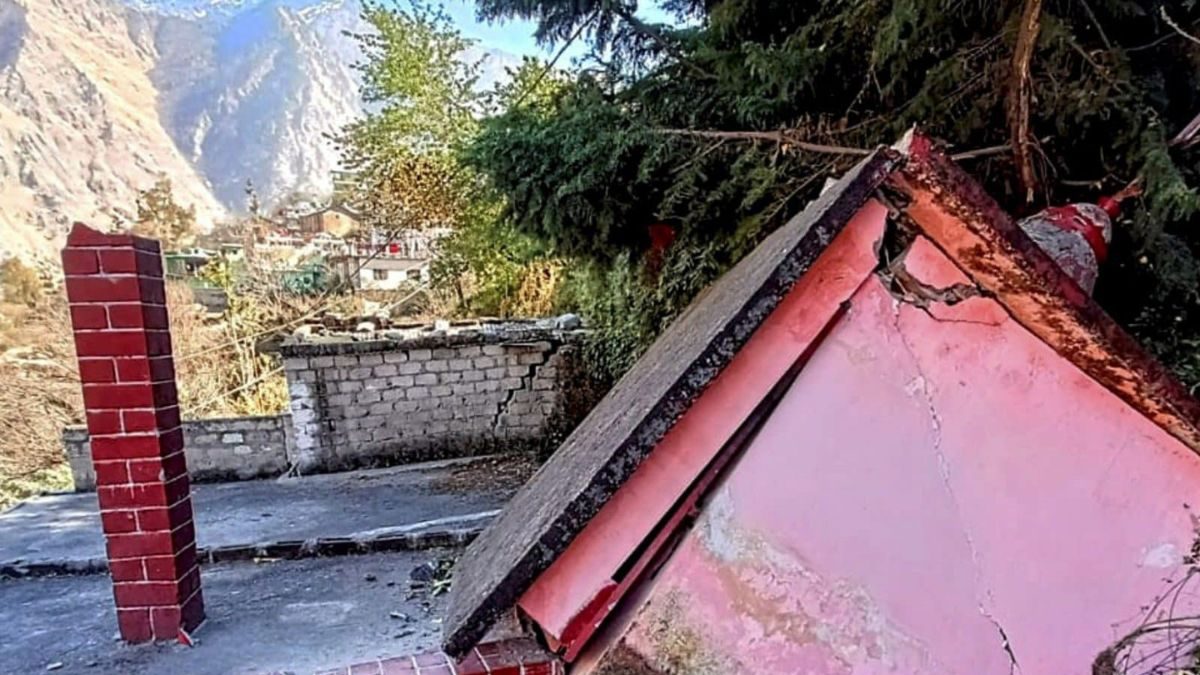A temple collapses after the gradual ‘sinking’ of Joshimath in Chamoli district of Uttarakhand, in Joshimath, in January. (PTI File)
A major calamity struck the Himalayan town of Joshimath, when a rapid subsidence event led to cracks in houses, forcing evacuation. The 1976 Mishra committee report had warned about the disaster and suggested remedial measures
The Centre on Thursday told Parliament that it is up to the Uttarakhand state government to take action on the recommendations of the Mishra Committee report, which had warned about the Joshimath disaster 47 years ago and suggested remedial measures.
The pilgrim town in Chamoli district of Uttarakhand has been gradually sinking for decades, however, a major calamity struck early this year, when wide cracks appeared in hundreds of houses, forcing local authorities to order evacuation.
ALSO READ | Did You Know ‘Sinking’ Joshimath is Built on Old Landslide? Shocking Facts, 50-yr-old Alert Explained
Thousands of people were forced to abandon their homes as water began gushing out of crevices on roads and buildings.
1976 MISHRA COMMITTEE REPORT
The 1976 Mishra committee constituted by then Uttar Pradesh government had warned of landslide and localised subsidence of Joshimath. The 18-member committee had suggested various long-term and short-term measures in accordance with the expertise and resources available with the member organizations during the time.
“Action on the recommendation of the Mishra Committee is required to be taken up by the Government of Uttarakhand,” said Minister of State Ashiwini Kumar Choubey, responding to a question on the action taken after the Joshimath crisis. The statement comes at a time when incessant rain has led to more cracks in the disaster-hit town.
“As per the National Policy on Disaster Management, the primary responsibility of disaster management, including disbursal of relief and rehabilitation of the people affected due to the disaster also rests with the State Government. The Central Government provides necessary financial and logistics support as per the established procedure,” he told the Rajya Sabha.
The Himalayan town is situated on a previous landslide debris that has low bearing capacity. Researchers have shown how excessive blasting has made the slopes weak and unstable.
STAY ON ALL CONSTRUCTION ACTIVITIES
The minister said that all construction activities have been stayed by the State Government in the entire Joshimath area, including Tapovan- Vishnugad power project and Helong Marwari Bypass Road, following the land subsidence incident.
“The situation is being continuously monitored at various levels in the State and Central Government. Further, the Central and State Governments are working in close coordination with all agencies concerned for mitigating the effect of land subsidence in Joshimath area,” he added.
ALSO READ | Joshimath Sinking: Anatomy of a Himalayan Disaster in the Making
Replying to the question on the number of projects sanctioned in the region in the past decade and whether any impact assessment was conducted before sanctioning such projects, the minister said that as per the records, in the past decade, the Environment Ministry has granted environmental clearances to Vishnugad Pipalkote Hydroelectric Project (444 MW installed capacity), Aerial Passenger Ropeway from Ghangaria to Hemkund Sahib (Phase-l) and Sanitary Landfill at Joshimath tehsil in Chamoli District, Uttarakhand, by following due procedure and incorporating requisite environmental safeguards.
He added that the Central Government had framed a detailed procedure for assessment of environmental and social impacts for developmental projects, which is prescribed in the Environment Impact Assessment Notification, 2006, and is amended from time to time.
“Environmental clearances are issued only after detailed study and analysis of developmental projects as per the notification and subject to compliance of necessary environmental safeguards. Project specific conditions related to safety measures such as installation of early warning telemetric system, implementation of emergency preparedness plan, disaster management plan, dam break analysis, catchment area treatment plan, stabilization of muck disposal sites, rim plantation, pasture development, nursery development, etc. are also prescribed in the environmental clearances to hydroelectric projects,” he added.



